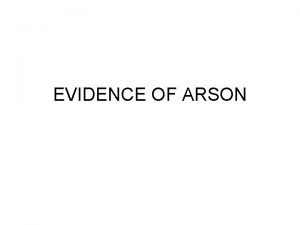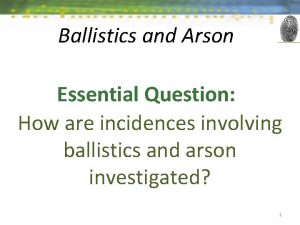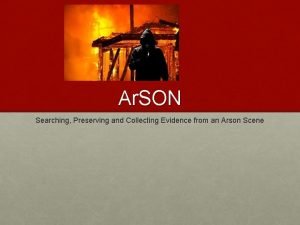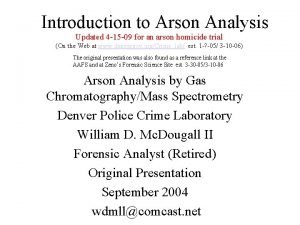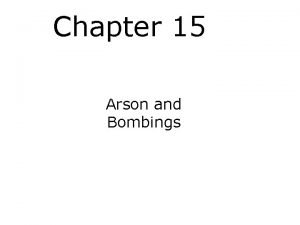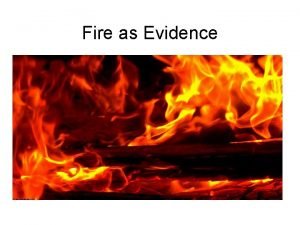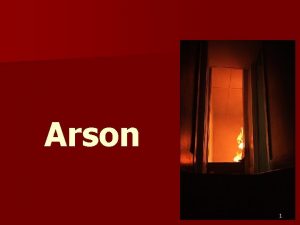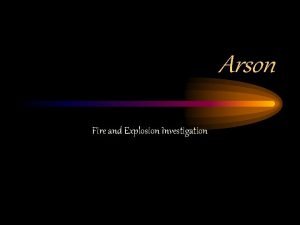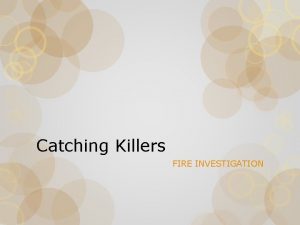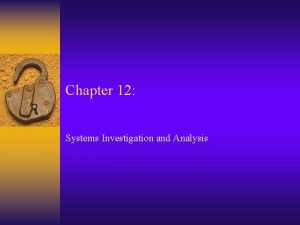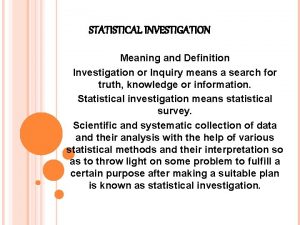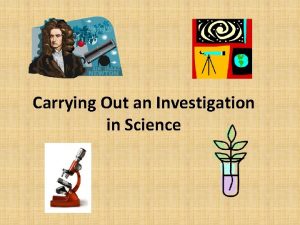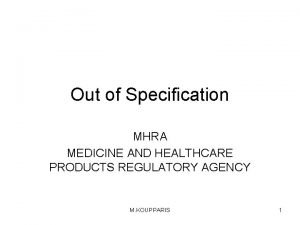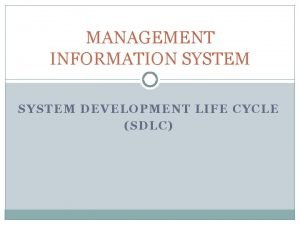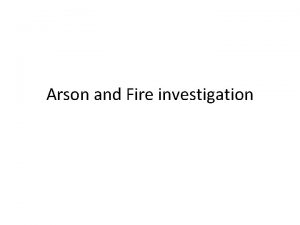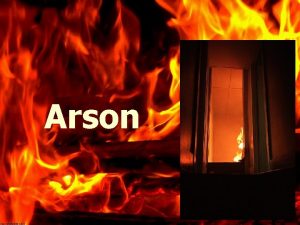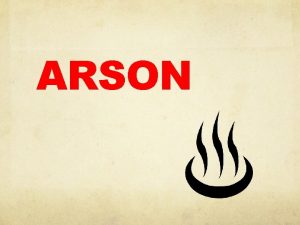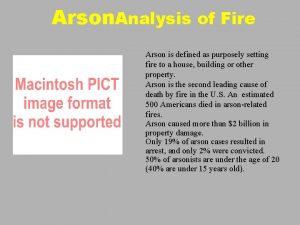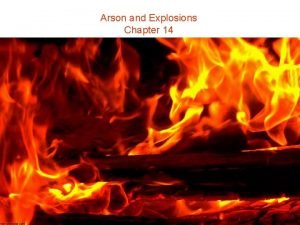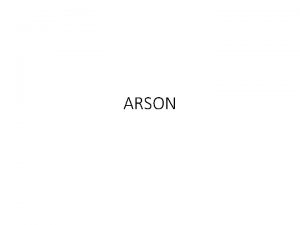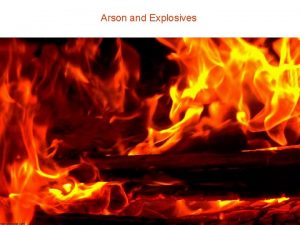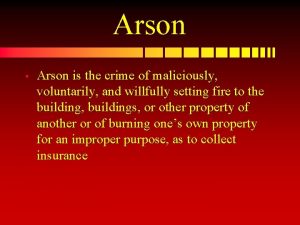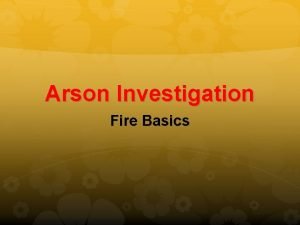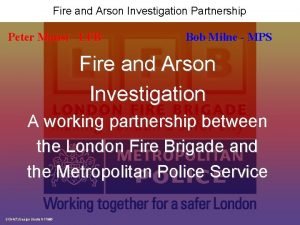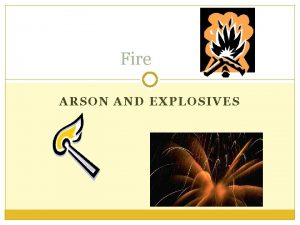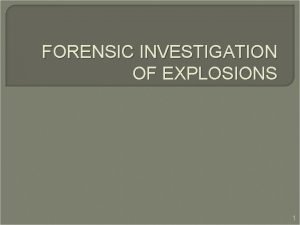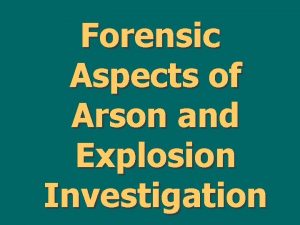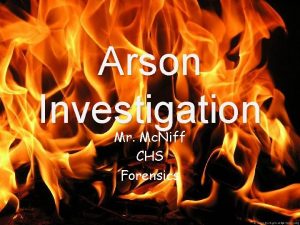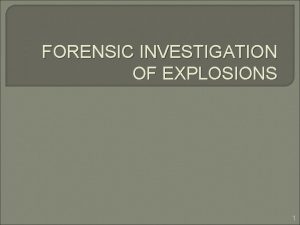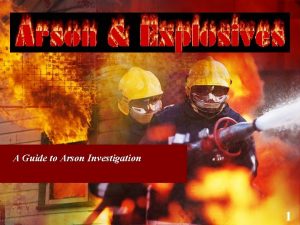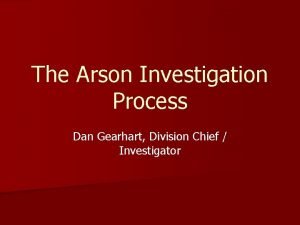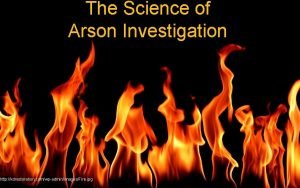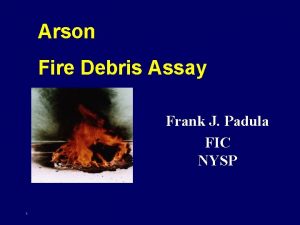Arson Fire Investigation o 1 LECTURE 10 IntroductionOutline






































- Slides: 38

Arson & Fire Investigation o 1 LECTURE #10

Introduction—Outline 1. 2. 3. 4. 6. 7. 8. 9. 2 Combustion reactions. Four factors to ignite and maintain a fire. Why arson is difficult to detect? Four categories of fire. Burn patterns in arson investigation. Arson evidence. Psychological profile of an arsonist. Motives for arson.

Introduction—Vocabulary o o o 3 accelerant - in fire investigation, any material used to start or sustain a fire; the most common are combustible liquids arson - the intentional and illegal burning of property combustion reaction – oxidation reaction that involves oxygen and that releases heat and light exothermic reaction – chemical reaction that releases heat of combustion - excess heat that is given off in a combustion reaction

Introduction—Vocabulary o o 4 hydrocarbon - any compound consisting only of hydrogen and carbon oxidation reaction - the complete or partial loss of electrons or gain of oxygen pyrolysis - decomposition of organic matter by heat in the absence of oxygen substrate control - a similar, but uncontaminated, sample; used for making comparisons

Happy Land Fire o o o 5 Julio Gonzalez and Lydia Feliciano dated off and on for six years. When Lydia ended the relationship, Julio set fire to the Happy Land Club in the Bronx. 87 people were trapped and died. Julio purchased the accelerant at a local station. Julio’s home and shoes smelled of gasoline.

Fire: rapid oxidation with evolution of heat and light.

Combustion o o o 7 Combustion reactions — oxidation reactions that involve oxygen and produce flames Heat of combustion — excess heat energy Exothermic reactions — chemical reactions that release heat

Fire Tetrahedron 4 ingredients are required to start a fire and keep it burning • • Oxygen Fuel Heat Chain reaction If one of them removed, the fire goes out: - Water cools the fire (heat) - Fire blanket (prevents O 2 from getting to the fire) - CO 2 extinguishers blow out the fire by blowing away O 2 8

Fire Four components of fire: 1) Fuel: material that is burning § § Fuel can be solid, liquid or gas Accelerant – used to start or maintain a fire Burning takes place at the surface of solids and liquids.

Fire Four components of fire: 2) Heat: Temperature at which fuel react with oxygen = ignition temperature 3) Oxygen: can be used up in closed spaces! 4) Chain Reaction: § continues to burn until all oxygen or fuel is used or removed; § the oxidation reaction must produce enough heat to maintain burning

State of matter o o 11 Most accelerants are hydrocarbons in a gas state: gasoline, kerosene, lighter fluid In a gas state, molecular bonding is weaker Liquid will not burn, but gas vapors will Vaporization — liquid to gas

Flash Point & Ignition Temperature Flash point — the lowest temperature at which a liquid fuel produces enough vapor to ignite (if given an ignition source). Ignition Temperature – the lowest temperature at which a fuel spontaneously ignites (without external help). 12

Pyrolysis o Solid fuels – not flammable o Vapors from solid fuels are flammable o o 13 As wood decomposes in fire, the vapors formed are flammable and will burn Pyrolysis – process of decomposition of organic matter caused by heat in the absence of oxygen.

Fire Investigation: First the point of origin is determined: § § Where the fires starts Usually contains the most damage. Once point of origin is determined, the cause of the fire is determined.

Cause of Fire: n Natural n Undetermined n Accidental n Intentional

ARSON Arson: The criminal act of deliberately setting fire to property (building or area). o The crime of starting an illegal fire. o The malicious act of setting fire. An example of arson: when a person sets their home on fire to collect the insurance.

Arson is Difficult to Prove o o o 17 The crime is usually carefully planned. The arsonist leaves the scene before anyone notices a fire. The fire destroys evidence. Extinguishing the fire also destroys evidence. Combustible liquids (accelerants) evaporate quickly

Function of a Fire Investigator o o o Investigation must begin quickly, before evidence is lost Find the fire’s point of origin Examine possible causes • • o Accidental Intentional Natural Arson? Classify the fire Who investigates the fire? 18 Fire & Arson Investigators at Fire Agencies together with Police, Fire Marshal Offices

Burn patterns 19

Determining Cause 20

Collecting the Evidence o o 21 Begin immediately; no warrant required Collect 3 -4 liters of ash from point of origin and other suspected areas Use portable vapor detectors, or sniffers Use trained dogs to sniff

What evidence can be collected? Paper/Trash – not much evidence § Accelerant – rapid start § Chemical device (road flares, propellant) § Electronic device for delayed ignition § Unburned portions of chemical and electronic devices may be left behind.

Fire > Collection of Evidence Even in a large fire, accelerant residues of flammable liquids may be left behind. Common: gasoline, kerosene, fuel oil § Rarer: alcohol, paint thinner § Unusual burn pattern may suggest use of liquid accelerant.

Collection of Evidence Accelerant remains can be detected by tracing the point of origin or canine use. Object containing accelerant must be packaged in air tight container.

Containers for Evidence § Metal cans: airtight, but old cans might rust § Glass Jars: rubber or glued liners may interfere with results. § Special airtight plastic evidence bags: must be properly sealed

Collection of Evidence § Along with sample from point of origin, a control sample should be collected. (material from a different room/location) § Carpet fibers (synthetics) may be “petroleum” based. § Obviously, evidence collection documented with photos, sketches, etc.

Analysis of Accelerants Gas Chromatography separates components and Mass Spectrometry identifies the components.

Collecting the Control o o 28 Place each sample in its own container Collect a substrate control — a debris sample that has not been contaminated by the accelerant Comparisons to the substrate control may help prove an accelerant was used Some products may look like accelerants when burned

Packaging the Debris o o 29 Use airtight containers such as a new clean paint can and lid Leave head space at the top of the can

Finding the Igniter o o o 30 Matches — often burns in the fire Cigarette lighters — often removed by arsonist Molotov cocktail — may leave glass fragments Faulty electrical wiring — an arc causes a predictable pattern Knowing the igniter helps form the criminal profile

Lab Analysis o o Heat the debris container to collect vapors in the head space Direct headspace extraction procedure • • o Passive headspace extraction procedure • • 31 Remove vapors with a syringe Analyze vapors with gas chromatography Suspend a charcoal-coated strip inside the can Replace lid Heat container 4 -16 hours at 50 -80 o. C Charcoal absorbs the vapor

Lab Analysis Passive headspace extraction procedure 32

Psychology of an Arsonist o o o Sense of power An emotional high No typical arsonist; possible characteristics: • Less than 25 y. o. • Father not in the home • Domineering mother • Academically challenged • Emotionally and/or psychologically disabled 33 • Unmarried • Living with parents • Inadequacy, insecurity • Fascination with fire • Alcoholism • Parental neglect or abuse

Motives for Arson o o o 34 Financial gain — insurance fraud Revenge, spite Excitement Vanity, hero syndrome Crime concealment — destroy evidence Vandalism

ARSON Statistics o o o Majority of the fires is connected to arsons. In most countries intentional fires, including arson fires comprise 15 -25% of reported fires Arsons take a large volume in the statistics of fire causes: • • 35 Russia UK USA Canada 7 - 8% of all fires, 18 to 20% of all fires 25 to 27% of all fires 20 to 30% of all fires.

Lecture Summary o o o 36 Fire: oxidation reaction that involves a combustible material. Not all oxidation reactions produce fire. Fire tetrahedron represents 4 requirements for sustained fire: oxygen, fuel, heat, chain reaction. Most fuels are hydrocarbons with very high ignition temperatures. The initial focus is to find the fire’s point of origin The burn pattern helps determine whether the fire was natural, accidental, or deliberate.

Lecture Summary o o o 37 Ash and debris are collected from the point of origin and other suspected area. Gas chromatography is used to analyze the accelerant residue. Most motives fit into 6 broad categories: financial gain, revenge, excitement, vanity, crime concealment, and vandalism.

Paul Sloane: “The innovative leader has to be an arsonist and a firefighter. ” 38
 Fire and arson investigation ppt
Fire and arson investigation ppt Burned fire scientist questions arson
Burned fire scientist questions arson Arson pour patterns
Arson pour patterns What is the definition of news item text
What is the definition of news item text Forensic science arson activity
Forensic science arson activity Arson
Arson Why is arson considered a low priority crime
Why is arson considered a low priority crime Line of demarcation fire
Line of demarcation fire Incendio
Incendio The boundary between charred and uncharred material.
The boundary between charred and uncharred material. David berkowitz arson
David berkowitz arson Catching killers fire investigation
Catching killers fire investigation 01:640:244 lecture notes - lecture 15: plat, idah, farad
01:640:244 lecture notes - lecture 15: plat, idah, farad Fire definition
Fire definition Reichstag fire who was the fire starter
Reichstag fire who was the fire starter Uttar pradesh fire prevention & fire safety rules, 2005
Uttar pradesh fire prevention & fire safety rules, 2005 Fire damper access
Fire damper access Rwi are
Rwi are What is grounded theory in qualitative research
What is grounded theory in qualitative research Saddam hussein apush
Saddam hussein apush What is system investigation
What is system investigation Special right triangle formulas
Special right triangle formulas Clinical investigation plan
Clinical investigation plan What does fccla stand for
What does fccla stand for Vce scientific poster
Vce scientific poster Meaning of statistical investigation
Meaning of statistical investigation Carrying out an investigation
Carrying out an investigation Euclidean geometry grade 11
Euclidean geometry grade 11 A systematic investigation
A systematic investigation English language nea investigation
English language nea investigation Continuous mortality investigation
Continuous mortality investigation Out of specification mhra guidelines
Out of specification mhra guidelines History scene investigation
History scene investigation During a recent police investigation
During a recent police investigation Feasibility study phase of sdlc
Feasibility study phase of sdlc Types of statistical investigation
Types of statistical investigation 1982ahmad österreich
1982ahmad österreich Personal investigation a level art
Personal investigation a level art Tcole crime scene investigation
Tcole crime scene investigation
